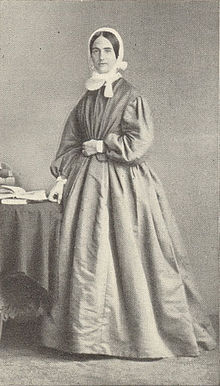
Back Diakonisse German Διακόνισσα Greek Diakonino Esperanto Diaconisa Spanish Diakonissa Finnish Diaconesse (communauté) French Diaconisa Galician מסדר הדיאקוניסות HE Diaconessa Italian 女性執事 Japanese

The ministry of a deaconess is a usually non-ordained ministry for women in some Protestant, Oriental Orthodox, and Eastern Orthodox churches to provide pastoral care, especially for other women, and which may carry a limited liturgical role. The word comes from the Greek diakonos (διάκονος), for "deacon", which means a servant or helper and occurs frequently in the Christian New Testament of the Bible.[1]
Deaconesses trace their roots from the time of Jesus Christ through to the 13th century in the West. They existed from the early through the middle Byzantine periods in Constantinople and Jerusalem; the office may also have existed in Western European churches.[1] There is evidence to support the idea that the diaconate including women in the Byzantine Church of the early and middle Byzantine periods was recognized as one of the major non-ordained orders of clergy.[2]
The English separatists unsuccessfully sought to revive the office of deaconesses in the 1610s in their Amsterdam congregation. Later, a modern resurgence of the office began among Protestants in Germany in the 1840s and spread through Nordic States, Netherlands, United Kingdom and the United States. Lutherans were especially active and their contributions are seen in numerous hospitals. The modern movement reached a peak about 1910, then slowly declined as secularization undercut religiosity in Europe and the professionalization of nursing and social work offered other career opportunities for young women.[3]
Deaconesses continue to serve in Christian denominations such as Lutheranism and Methodism, among others.[3][4] In those denominations, before they begin their ministry, they are consecrated as deaconesses.[5]
Non-clerical deaconesses should not be confused with women ordained deacons such as in the Anglican churches, the Methodist churches, and the Protestant Church in the Netherlands, many of which have both ordained deacons and consecrated deaconesses; in Methodism, the male equivalent to female deaconesses are Home Missioners.[6]
- ^ a b Macy, Gary (2007). The Hidden History of Women's Ordination: Female Clergy in the West. Oxford University Press.
- ^ Karras, Valerie A. (June 2004). "Female Deacons in the Byzantine Church". Church History. 73 (2): 272–316. doi:10.1017/S000964070010928X. ISSN 0009-6407. S2CID 161817885.
- ^ a b Zagore, Robert. "Deaconess Ministry". Lutheran Church—Missouri Synod. Retrieved 16 June 2021.
- ^ Brooks, Alexander; Hunter, Louis Sr. "For Deaconesses". Columbus Avenue African Methodist Episcopal Zion Church.
- ^ Naumann, Cheryl D. (2009). In the Footsteps of Phoebe: A Complete History of the Deaconess Movement in the Lutheran Church—Missouri Synod. Concordia Publishing House. p. 234. ISBN 978-0-7586-0831-4.
- ^ "Deaconess & Home Missioner Ministry". United Methodist Women. Archived from the original on 24 June 2021. Retrieved 16 June 2021.